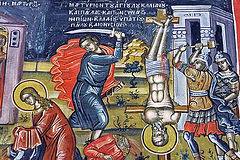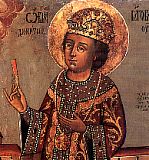

| Previous day | Next day |
| Old Style
June 3
|
Thursday |
New Style
June 16
|
| First Week after Pentecost (Fast-free period). Tone 7. | No fast.
|
![]() Martyrs Lucillian and those with him at Byzantium: four youths—Claudius, Hypatius, Paul, and Dionysius—and the virgin Paula (ca. 270-275).
Martyrs Lucillian and those with him at Byzantium: four youths—Claudius, Hypatius, Paul, and Dionysius—and the virgin Paula (ca. 270-275).
Hieromartyrs Lucian, bishop, Maxianus, priest, and Julian, deacon and Martyrs Marcellinus and Saturninus, at Beauvais (Gaul) (ca. 81-96). Translation of the relics of the martyred Crown Prince Demetrius from Uglich to Moscow (1606).
New Hieromartyr Cyprian (Nelidov), hieromonk, of Moscow (1934).
“Surety of Sinners” Icon of the Most Holy Theotokos (Korets) (1622).
St. Achilles, bishop of Alexandria (312). St. Hieria, widow, of Mesopotamia (312). Monk-martyr Barsabas, abbot, of Ishtar, and ten companions, in Persia (342). St. Clotilde (Chlotilda), queen of France (545). Monk-martyr Isaac of Cordoba (851). St. Athanasius the Wonderworker, hieromonk of Traiannou Monastery in Bithynia (ca. 933). New Hieromartyr Joseph, metropolitan of Thessalonica (1821).
Repose of Archimandrite Justin (Parvu) of Petru Voda Monastery (Romania) (2013).
Thoughts for Each Day of the Year
According to the Daily Church Readings from the Word of God
By St. Theophan the Recluse

Thursday. [Rom. 1:28–2:9; Matt. 5:27–32]
Whosoever looketh on a woman … hath committed adultery with her already (Matt. 5:28). Living in society, one cannot help looking at women. What to do? A man does not commit adultery simply by looking at a woman, but by looking at her with lust. Look if you must, but keep your heart on a leash. Look with the eyes of a child—purely, without any evil thoughts. One must love women as well, for they are not excluded from the commandment about love of neighbour—but with love that is pure, which bears the soul and spiritual aspect in mind. Just as there is neither male nor female before God in Christianity, so it is in the mutual relations of Christians. But this is very difficult, you will say. Yes, it does not happen without a struggle; but struggle presupposes a lack of desire for evil. The Lord counts as purity the unlustful desire of the merciful.
Articles
 Hieromartyr Lucian the Bishop at Beauvais in FranceThe Hieromartyr Lucian lived in Rome, and his pagan name was Lucius. He was converted to Christ by the Apostle Peter, and was baptized. |
 Hieromartyr Maximian the Presbyter at Beauvais in FranceSaint Maximian the priest was one of the companions of Saint Lucian, and assisted him in proclaiming the Gospel in the West. |
 Martyr Julian the Deacon at Beauvais in FranceSaint Julian the deacon was one of the companions of Saint Lucian, and assisted him in proclaiming the Gospel in the West. |
 Martyr Marcellinus at Beauvais in FranceSaint Marcellinus was one of the companions of Saint Lucian, and assisted him in proclaiming the Gospel in the West. |
 Hieromartyr Saturninus at Beauvais in FranceSaint Saturninus was one of the companions of Saint Lucian, and assisted him in proclaiming the Gospel in the West. |
 Translation of the relics of slain Crown Prince Demetrius of MoscowThe Tsarevich Saint Demetrius, murdered on May 15, 1591, was glorified in the year 1606. |


